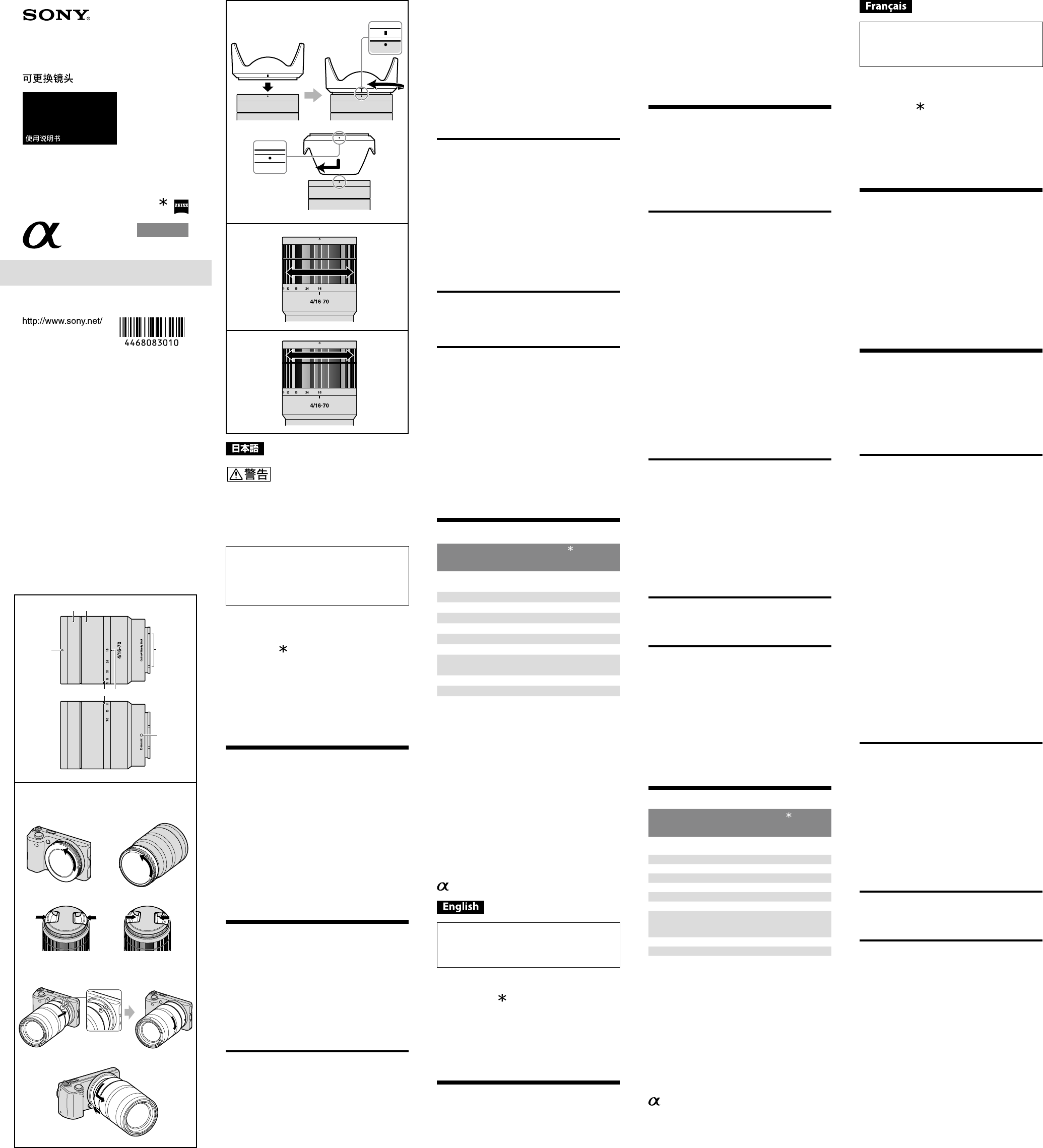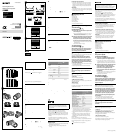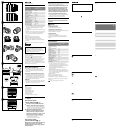
–1
(1) (2)
–2
2
1 6
7
3
4 5
E
A
Vario-Tessar T E 16-70mm F4 ZA OSS
E
http://www.sony.co.jp/DSLR/support/
1
2
1
2
3
4
5
6 *
7
*
(
–
)
1
(1) (2) 2
(2)
2
(
–
)
3
DMF
Vario-Tessar T
E 16-70mm F4 ZA OSS
(SEL1670Z)
35mm *
(mm)
24-105
12-16
*
83°-23°
** (m)
0.35
( )
0.23
F22
(mm)
55
( mm)
66.6×75
( g)
308
* 35mm APS-C
**
1 1
1 1
1
This instruction manual explains how to use lenses.
Notes on use are found in the separate “Precautions
before using”. Be sure to read both documents before
using your lens.
This lens is designed for Sony α camera system E-mount
cameras. You cannot use it on A-mount cameras.
The Vario-Tessar T
E 16-70mm F4 ZA OSS was
developed jointly by Carl Zeiss and Sony Corporation and
designed for Sony E-mount cameras. This lens is produced
under the strict standards and quality assurance system of
Carl Zeiss.
For further information on compatibility, visit the Sony
web site in your area, or consult your Sony dealer or local
authorized Sony service facility.
Notes on Use
When carrying a camera with the lens attached, always firmly
hold both the camera and the lens.
Do not hold by the part of the lens that protrudes when
zooming.
Precautions on using a flash
When using a flash, always remove the lens hood and shoot
at least 1 m (3.3 feet) away from your subject. With certain
combinations of lens and flash, the lens may partially block
the light of the flash, resulting in a shadow at the bottom of
the picture.
Vignetting
When using the lens, the corners of the screen become darker
than the center. To reduce this phenomena (called vignetting),
close the aperture by 1 to 2 stops.
Identifying the Parts
1 Hood index
2 Focusing ring
3 Zooming ring
4 Focal-length scale
5 Focal-length index
6 Lens contacts*
7 Mounting index
* Do not touch the lens contacts.
Attaching and Detaching the Lens
To attach the lens
(See illustration
–
.)
1
R
emove the rear and front lens caps and the
camera body cap.
You can attach/detach the front lens cap in two ways, (1)
and (2). When you attach/detach the lens cap with the
lens hood attached, use method (2).
2
Align the white index on the lens barrel with
the white index on the camera (mounting
index), then insert the lens into the camera
mount and rotate it clockwise until it locks.
Do not press the lens release button on the camera when
mounting the lens.
Do not mount the lens at an angle.
To remove the lens
(See illustration
–
.)
While holding down the lens release button on
the camera, rotate the lens counterclockwise
until it stops, then detach the lens.
Attaching the Lens Hood
It is recommended that you use a lens hood to reduce flare
and ensure maximum image quality.
Align the red line on the lens hood with the
red dot on the lens (hood index), then insert
the lens hood into the lens mount and rotate it
clockwise until it clicks into place and the red
dot on the lens hood is aligned with the red dot
on the lens (hood index).
When using a flash with the camera, remove the lens hood to
avoid blocking the flash light.
When storing, fit the lens hood onto the lens backwards.
Zooming
Rotate the zooming ring to the desired focal
length.
Focusing
There are three ways to focus.
Auto focus
The camera focuses automatically.
DMF (Direct manual focus)
After the camera focuses in auto focus, you can make a fine
adjustment manually.
Manual focus
You focus manually.
For details on mode settings, refer to the instruction manual
supplied with the camera.
Specifications
Product name
(Model name)
Vario-Tessar T
E 16-70mm F4 ZA OSS
(SEL1670Z)
Equivalent 35mm-format focal
length* (mm)
24-105
Lens groups-elements
12-16
Angle of view*
83°-23°
Minimum focus** (m (feet))
0.35 (1.15)
Maximum magnification (X)
0.23
Minimum f-stop
f/22
Filter diameter (mm)
55
Dimensions (maximum
diameter × height)
(approx., mm (in.))
66.6×75
(2 5/8×3)
Mass (approx., g (oz))
308 (10.9)
Shake compensation function
Yes
* The values shown above for equivalent 35mm-format
focal length and angle of view are for Interchangeable Lens
Cameras equipped with an APS-C sized image sensor.
** Minimum focus is the distance from the image sensor to the
subject.
Depending on the lens mechanism, the focal length may
change with any change in shooting distance. The focal
lengths given above assume the lens is focused at infinity.
Included items
Lens (1), Front lens cap (1), Rear lens cap (1),
Lens hood (1), Lens case (1), Set of printed documentation
Design and specifications are subject to change without
notice.
is a trademark of Sony Corporation.
4-468-083-01(1)
©2013 Sony Corporation
SEL1670Z
Interchangeable Lens
Objectif interchangeable
Operating Instructions
Mode d’emploi
Manual de instrucciones
Vario-Tessar T
E 16-70mm F4 ZA OSS
E-mount
Printed in Thailand
Cette notice explique comment se servir des objectifs.
Les remarques sur l’emploi se trouvent dans les
« Précautions avant toute utilisation » séparées. Veuillez
lire les deux documents avant d’utiliser votre objectif.
Votre objectif est conçu pour les appareils photo à monture
E de type Sony α. Il ne peut pas être utilisé pour les appareils
photo à monture A.
Le Vario-Tessar T
E 16-70mm F4 ZA OSS qui a
été développé en collaboration par Carl Zeiss et Sony
Corporation est destiné aux appareils photo à monture E de
Sony. Cet objectif a été fabriqué selon les normes strictes et
le système d’assurance qualité de Carl Zeiss.
Pour plus d’informations sur la compatibilité, consultez le site
de Sony de votre pays, ou adressez-vous à un revendeur Sony ou
à un service après-vente agréé Sony.
Remarques sur l’emploi
Lorsque vous portez un appareil photo avec l’objectif dessus,
tenez toujours fermement l’appareil photo et l’objectif.
Ne tenez pas l’appareil photo par la partie de l’objectif qui
ressort lors d’un zoom.
Précautions concernant l’emploi d’un flash
Lorsque vous utilisez un flash, retirez toujours le parasoleil et
prenez vos photos à au moins 1 m (3,3 pieds) du sujet. Associé
à certains types de flash, l’objectif peut bloquer partiellement
la lumière du flash et produire un ombre au bas de l’image.
Vignetage
Lorsque l’objectif est utilisé, les coins de l’écran deviennent
plus sombres que le centre. Pour réduire ce phénomène
(appelé vignetage), fermez l’ouverture de 1 ou 2 crans.
Identification des éléments
1 Repère de parasoleil
2 Bague de mise au point
3 Bague de zoom
4 Échelle de focale
5 Repère de focale
6 Contacts d’objectif*
7 Repère de montage
* Ne touchez pas les contacts d’objectif.
Pose et dépose de l’objectif
Pour poser l’objectif
(Voir l’illustration –.)
1
Déposez les capuchons d’objectif avant et
arrière et le capuchon de l’appareil photo.
Vous pouvez poser et déposer les capuchons d’objectif
avant de deux façons, (1) et (2). Si vous posez/déposez le
capuchon d’objectif avec le parasoleil, utilisez la méthode
(2).
2
Alignez le repère blanc du barillet d’objectif
sur le repère blanc de l’appareil photo
(repère de montage), puis posez l’objectif
sur la monture de l’appareil photo et
tournez-le dans le sens horaire de sorte qu’il
s’encliquette.
N’appuyez pas sur le bouton de libération de l’objectif sur
l’appareil photo lorsque vous posez l’objectif.
Ne posez pas l’objectif de biais.
Pour déposer l’objectif
(Voir l’illustration –.)
Tout en appuyant sur le bouton de libération de
l’objectif sur l’appareil photo, tournez l’objectif
dans le sens antihoraire jusqu’à l’arrêt, puis
déposez l’objectif.
Fixation du parasoleil
Il est conseillé d’utiliser un parasoleil pour réduire la
lumière parasite et obtenir la meilleure image possible.
Alignez la ligne rouge du parasoleil sur le point
rouge de l’objectif (repère de parasoleil), puis
insérez le parasoleil sur la monture d’objectif et
tournez-le dans le sens horaire jusqu’à ce qu’il
s’encliquette et le point rouge du parasoleil
s’aligne sur le point rouge de l’objectif (repère
de parasoleil).
Si vous utilisez un flash avec l’appareil photo, retirez le
parasoleil pour éviter de bloquer la lumière du flash.
Pour ranger le parasoleil, insérez-le à l’arrière de l’objectif.
Zooming
Tournez la bague de zoom selon la focale
souhaitée.
Mise au point
La mise au point peut être faite de trois façons.
Autofocus
L’appareil photo fait automatiquement la mise au point.
DMF (Mise au point manuelle directe)
Après la mise au point en autofocus, vous pouvez effectuer
un réglage plus fin manuellement.
Mise au point manuelle
Vous faites vous-même la mise au point.
Pour le détail sur les réglages de mode, reportez-vous au
mode d’emploi fourni avec l’appareil photo.
(Suite à la page arrière)




